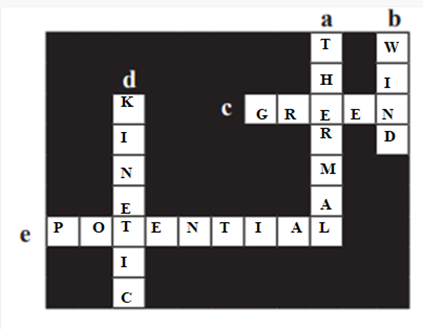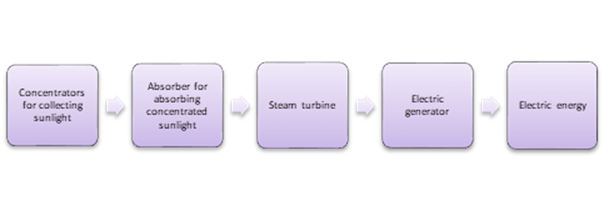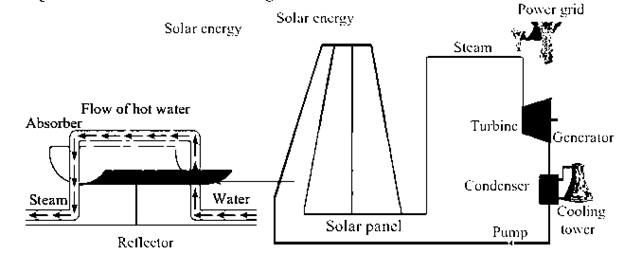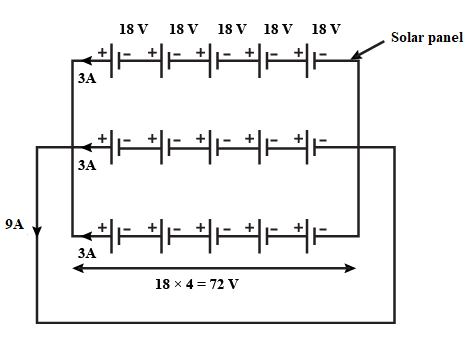Class 10 MAHARASHTRA STATE TEXTBOOK BUREAU Solutions Science Chapter 5 - Towards Green Energy
Towards Green Energy Exercise Exercise
Solution 1
|
I |
II |
III |
|
Coal |
Thermal energy |
Thermal plant |
|
Uranium |
Nuclear energy |
Nuclear power plant |
|
Water Reservoir |
Potential energy |
Hydroelectric plant |
|
Wind |
Kinetic Energy |
Wind electricity plant |
Solution 2
Coal is used in thermal power plant.
Problems associated with this type of power generation: -
- Burning of coal causes air pollution.
- Along with emission of gases, soot particles are also released into the environment.
- In the near future, there will be limitations on the availability of coal.
Solution 3a
Other than thermal power plant, nuclear power plants, solar power plants use thermal energy for power generation.
Different ways of generating thermal energy are: -
- Using fossil fuels: By burning fossil fuels, chemical energy of coal, petroleum, is converted to thermal energy.
- Using natural gas: Chemical energy in natural gas is converted to thermal energy
- Using nuclear fuels: Controlled chain reaction in nuclear power plants release huge amount of thermal energy.
- Using solar energy: Solar energy can be reflected and absorbed in absorbers where it is converted to thermal energy.
- Using geothermal energy: Underground water, sometimes comes in contact with hotspot and the steam generated is then collected in hot springs. Thus, geothermal energy is converted to heat energy.
Solution 4
Thermal energy-based power generation involves 5 steps of energy conversion.

Nuclear energy based power generation also involves 5 steps: -

The power generation by solar photovoltaic cells involves minimum number of steps:

Solution 5

Solution 6
|
Conventional Sources |
Non-conventional Sources |
|
Conventional sources of energy (e.g., coal, petroleum and natural gas) are non-renewable sources of energy. |
Non-conventional sources of energy (e.g., solar and wind energy) are renewable sources of energy. |
|
They have been in use since a long time. For example, firewood and coal have been in use since a long time. |
These sources have recently developed and are still developing. For example, the technology of producing electricity from solar panels has recently developed. |
|
Most of these energy sources (e.g., coal and firewood) cause pollution when used. |
They do not cause any pollution (e.g., solar energy, geothermal energy etc.) |
|
They are common and widely used sources (e.g., thermal power). |
They are comparatively new sources of energy and hence are not widely used. For example, solar panels and wind mills are not widely used. |
|
Thermal electricity generation |
Solar thermal electricity generation |
|
It uses non - renewable source of energy for electricity generation. |
It uses renewable source of energy for electricity generation. |
|
This method of electricity generation is not eco- friendly as it causes air pollution. |
This power generation is eco-friendly. |
Solution 7
- Green energy is that energy which does not pollute the environment and is renewable in nature.
- The energy sources such as sunlight, wind, rain and tides are green energy as they are available naturally and do not harm environment.
Solution 8a
- Fossil fuels release oxides of carbon, nitrogen, sulphur, etc. that cause acid rain, which affects the soil fertility and potable water.
- Burning of fossil fuels produce gases such as carbon dioxide that causes global warming.
- Burning of coal and petroleum produces a lot of pollutants causing air pollution.
Solution 8b
- Energy is everywhere but we can see that harnessing this energy is both difficult as well as costly. If we continue exploiting our non-renewable resources, they will soon be exhausted. The need of the hour is to better utilize our existing resources.
- Energy conservation is the most economical solution to the shortage of energy as it reduces the consumption of energy.
- We as citizens should minimize the use of energy resources through conservation methods like using of public transport, by switching off the lights, fans, televisions, computers when not in use, using energy saving devices and keeping the lights in our homes dust free. Each one of us can make a difference by not wasting energy. Energy saved is energy generated.
Solution 9
a.Many identical solar cells connected together forms a solar panel. Now many such solar panels are connected in series in a form of solar string to get required voltage. Many identical solar strings are connected in parallel to get the required current. Hence, in this way we get the required amount of energy by connecting solar panels.
b.
Advantages of using Solar Cells:
- The source of energy for solar cell is present in abundance.
- They have no moving parts, and hence require little maintenance and work quite satisfactorily without any focusing device.
- They do not cause any environmental pollution like the fossil fuels and nuclear power.
- Solar cells last a longer time and have low running costs.
Limitations:
- The entire process of manufacture is very expensive
- Also, silver is used for interconnection of these cells in the panel, which is a very expensive metal.
- A practical problem linked with the use of solar cell panels is regarding the storage of electricity general by them.
Solution 10a

- Gas emitted due to combustion of coal in the boiler turns the turbine at high pressure and high temperature.
- Once the turbine is rotated, the pressure of the steam and the temperature decrease.
- So, steam gets converted back to water by removing heat in the condenser with a cooling tower.
- Even though a thermal power plant generates a large amount of electrical energy, it has its disadvantages.
Solution 10b

- Plutonium or uranium generates steam of high temperature and high pressure.
- The steam rotates the turbines.
- Thus, here nuclear energy is converted to thermal energy and then to kinetic energy which rotates the turbine which is converted to electrical energy.
Solution 10c

- Thermal energy generated from solar radiation is also used for generation of electricity.
- Reflectors reflect and concentrate solar radiation on the absorbers.
- This solar energy is then converted to heat energy.
This heat energy is utilised to generate steam which drives the turbine and generator.
Solution 10d

- Kinetic energy in flowing water or potential energy in water is a conventional source of energy.
- Potential energy in water stored in a dam is converted to kinetic energy.
- Kinetic energy of flowing water rotates the turbine and the turbine generates electricity.
Solution 11a
- The construction of turbine is different for different types of power plants. This depends on the type of energy source used for driving the turbine
- In thermal power plants, steam turbine is used while in hydro-power plant, water turbine is used.
Solution 11b
- Large amount of energy is generated in a matter of seconds in a fission reaction. If the fission reaction is not controlled it may be fatal to living beings surrounding.
- Uncontrolled fission reaction may lead to the emission of harmful radiation.
- It can also lead to the meltdown of the nuclear power plant.
Solution 11c
- A natural source providing us energy continuously is called a renewable source of energy.
- Hydroelectric energy, solar energy and wind energy are sources of energy which can be used again and again and will never get exhausted.
- They are also called the non- conventional sources of energy.
Solution 11d
- Solar photovoltaic cells which have energy producing capacity of mW, are connected in required series and parallel combinations to form a solar panel.
- Many solar panels are connected in series to form a solar string and many solar strings are connected in parallel to form a solar array which has energy producing capacity of MW.
- Thus, with required series and parallel combination of solar photovoltaic cells to form solar panels, solar strings and solar arrays, it is possible to produce energy from mW to MW capacity.
Solution 12a

Solution 12b

Solution 13
- While generating electricity using this power plant there is no harmful chemicals and gases released in water bodies.
- Also, water is a renewable source of energy.
- Thus, hydroelectric power plants are environment friendly.
Solution 14a

Solution 14b

Solution 15
Electricity generation based on fossil fuels like coal, natural gas and nuclear fuels like uranium and plutonium are not environment friendly. It means, that if electrical energy is generated using these fuels causes environmental degradation.
- We have seen that burning of fossil fuels like coal, and
natural gas leads to emission of certain gases which results in air pollution.
It adversely affects our health. Increase in percentage of carbon dioxide in the air due to burning of fuels affects environment
severely.
The phenomena of global warming is an example of this. Nitrogen dioxide generated due to burning of fuels like coal, diesel, petrol, etc. leads to problems like acid-rain. - Fossil fuels like coal, crude oils and natural gases (LPG and CNG) forms after million years thus, their reserves are limited. They are going to deplete in future. It is said that with the current speed of their use, the coal reserves in the world would last for another about 200 years or so and the natural gas reserves for about 200-300 years.
- An accident in nuclear power plant can be very fatal. This is because the accident may result in release of very harmful radiations.
This is how the energy generation affects the environment.

